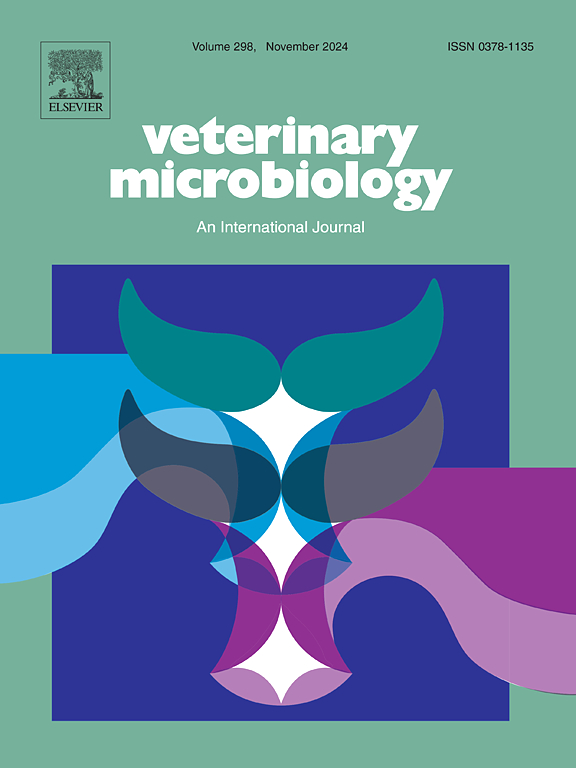Evidence of autophagic and Wnt/β-catenin signaling occurrence during Schmallenberg virus (SBV) infection on BHK-21 cells
IF 2.4
2区 农林科学
Q3 MICROBIOLOGY
引用次数: 0
Abstract
Schmallenberg virus (SBV) is a ruminant pathogen that is widely distributed around the world, but little is known about its interactions with permissive cells or about its pathogenetic mechanisms. This study highlighted, through a phenotypic approach, the changes in the expression of some autophagy and Wnt/β-catenin pathway markers that SBV causes on baby hamster kidney (BHK-21) cells. Western blot analysis revealed that SBV caused autophagy induction at 48 h post infection. Several markers, such as PI3K, Akt, and Wnt/β-catenin, were downregulated at the same time point. Furthermore, downregulation in the expression of PI3K, p-mTOR and Beclin-1 showed differences between multiplicity of infection (MOI) 0.05 and 0.5, but not between MOI 0.5 and 1.5. Exceptions for this trend were Akt and LC3-II, which progressively decreased depending on time, and β-catenin, whose expression almost disappeared regardless of MOI. The use of several chemical inducers and inhibitors has demonstrated the efficacy of late autophagy inhibitors (bafilomycin and chloroquine) in significantly lowering SBV infection and also preventing the changes caused by viral replication. Early autophagy inhibitors and inducers showed no effect on cellular viability or viral titers. Silencing the expression of Akt and β-catenin revealed a slight increase in the expression of viral glycoprotein Gc. These findings revealed the relationship that SBV has in important cellular regulatory pathways, expanding the knowledge about the cellular interactions of this virus and suggesting a central role for late stages of autophagy in the replication of this bunyavirus.
施马伦伯格病毒(SBV)感染BHK-21细胞时发生自噬和Wnt/β-catenin信号传导的证据
施马伦伯格病毒(Schmallenberg virus, SBV)是一种广泛分布在世界各地的反刍动物病原体,但对其与容许细胞的相互作用及其发病机制知之甚少。本研究通过表型方法强调了SBV引起的一些自噬和Wnt/β-catenin通路标志物在幼鼠肾(BHK-21)细胞上的表达变化。Western blot分析显示SBV在感染后48 h诱导自噬。PI3K、Akt、Wnt/β-catenin等标志物在同一时间点下调。此外,PI3K、p-mTOR和Beclin-1表达下调在感染多重性(MOI) 0.05和0.5之间存在差异,而在MOI 0.5和1.5之间无差异。这种趋势的例外是Akt和LC3-II,它们随着时间的推移逐渐降低,而β-catenin的表达几乎消失,与MOI无关。几种化学诱导剂和抑制剂的使用已经证明了晚期自噬抑制剂(巴菲霉素和氯喹)在显著降低SBV感染和防止病毒复制引起的变化方面的功效。早期的自噬抑制剂和诱导剂对细胞活力或病毒滴度没有影响。沉默Akt和β-catenin的表达后,病毒糖蛋白Gc的表达略有增加。这些发现揭示了SBV在重要的细胞调控途径中的关系,扩大了对该病毒细胞相互作用的认识,并提示了自噬后期在该布尼亚病毒复制中的核心作用。
本文章由计算机程序翻译,如有差异,请以英文原文为准。
求助全文
约1分钟内获得全文
求助全文
来源期刊

Veterinary microbiology
农林科学-兽医学
CiteScore
5.90
自引率
6.10%
发文量
221
审稿时长
52 days
期刊介绍:
Veterinary Microbiology is concerned with microbial (bacterial, fungal, viral) diseases of domesticated vertebrate animals (livestock, companion animals, fur-bearing animals, game, poultry, fish) that supply food, other useful products or companionship. In addition, Microbial diseases of wild animals living in captivity, or as members of the feral fauna will also be considered if the infections are of interest because of their interrelation with humans (zoonoses) and/or domestic animals. Studies of antimicrobial resistance are also included, provided that the results represent a substantial advance in knowledge. Authors are strongly encouraged to read - prior to submission - the Editorials (''Scope or cope'' and ''Scope or cope II'') published previously in the journal. The Editors reserve the right to suggest submission to another journal for those papers which they feel would be more appropriate for consideration by that journal.
Original research papers of high quality and novelty on aspects of control, host response, molecular biology, pathogenesis, prevention, and treatment of microbial diseases of animals are published. Papers dealing primarily with immunology, epidemiology, molecular biology and antiviral or microbial agents will only be considered if they demonstrate a clear impact on a disease. Papers focusing solely on diagnostic techniques (such as another PCR protocol or ELISA) will not be published - focus should be on a microorganism and not on a particular technique. Papers only reporting microbial sequences, transcriptomics data, or proteomics data will not be considered unless the results represent a substantial advance in knowledge.
Drug trial papers will be considered if they have general application or significance. Papers on the identification of microorganisms will also be considered, but detailed taxonomic studies do not fall within the scope of the journal. Case reports will not be published, unless they have general application or contain novel aspects. Papers of geographically limited interest, which repeat what had been established elsewhere will not be considered. The readership of the journal is global.
 求助内容:
求助内容: 应助结果提醒方式:
应助结果提醒方式:


